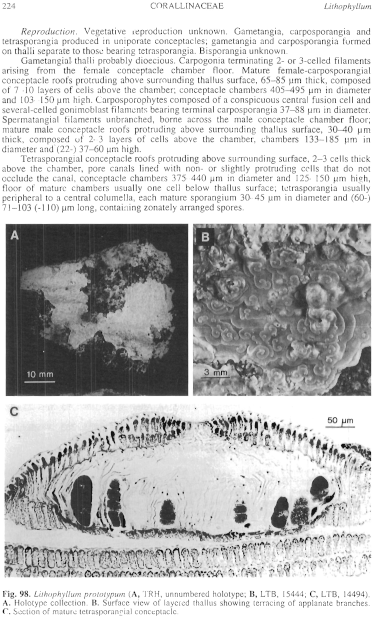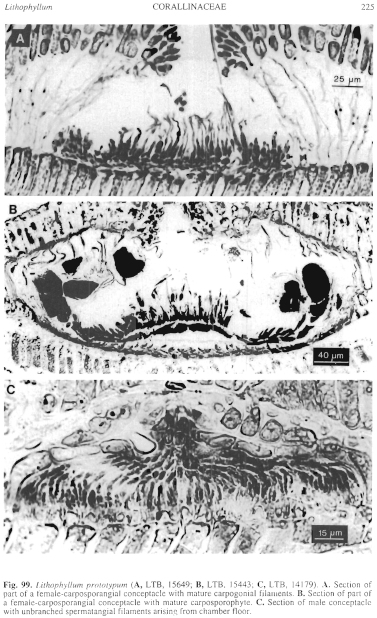|
|
|
|
|
|||||||||||
|
Electronic Flora of South Australia Species Fact Sheet
Phylum Rhodophyta – Class Florideophyceae – Order Corallinales – Family Corallinaceae – Subfamily Lithophylloideae
Selected citations: Woelkerling & Campbell 1992: 67, figs 42–49.
Synonyms
Dermatolithon prototypum (Foslie) Foslie 1900c: 22.
Goniolithon prototypum (Foslie) Setchell & Mason 1943: 89.
Lithothamnion prototypum Foslie 1897: 18. Woelkerling 1993: 179.
Melobesia prototypa (Foslie) Foslie 1898b: 11.
Tenarea prototypa (Foslie) Adey 1970: 7.
Titanoderma prototypum (Foslie) Woelkerling et al. 1985: 333. Chamberlain 1991: 6, 13, figs 5, 6. D. Littler et al. 1989: 218.
Lithophyllum tessellatum Lemoine 1930: 68.
Tenarea tessellata (Lemoine) M. Littler ex Adey et al. 1982: 35, figs 21, 22. M. Littler 1971: 355, figs 1–10.
Titanoderma tessellatum (Lemoine) Woelkerling et al. 1985: 333. Woelkerling 1988: 110, 114, figs 88, 94, 96.
Additional references are given by Woelkerling & Campbell 1992.
Thallus normally pinkish, encrusting to layered or rarely with isolated lumpy outgrowths, mostly 20–50 mm across and 0.1–0.9 mm thick, epigenous and partially or completely affixed by cell adhesion; lamellate branches usually present, applanate, conspicuous and giving the thallus surface a terraced appearance. Structure pseudoparenchymatous with dorsiventral organisation throughout; construction dimerous, consisting of a single ventral layer of branched, laterally cohering, filaments each usually composed of palisade cells 5–14 µm long and 15–50 (–70) µm high, and additionally of epithallial cells that arise dorsally and more or less perpendicularly from most cells of ventral layer filaments and are 4–9 µm in diameter and 2–6 µm long with distal walls rounded or flattened but not flared; cells of adjacent filaments joined by secondary pit-connections; cell-fusions and haustoria unknown; trichocytes rare, occurring singly or in groups.
Reproduction: Vegetative reproduction unknown. Gametangia, carposporangia and tetrasporangia produced in uniporate conceptacles; gametangia and carposporangia formed on thalli separate to those bearing tetrasporangia. Bisporangia unknown.
Gametangia• thalli probably dioecious. Carpogonia terminating 2- or 3-celled filaments arising from the female conceptacle chamber floor. Mature female-carposporangial conceptacle roofs protruding above surrounding thallus surface, 65–85 µm thick, composed of 7–10 layers of cells above the chamber; conceptacle chambers 405–495 µm in diameter and 103–150 µm high. Carposporophytes composed of a conspicuous central fusion cell and several-celled gonimoblast filaments bearing terminal carposporangia 37–88 µm in diameter. Spermatangial filaments unbranched, borne across the male conceptacle chamber floor; mature male conceptacle roofs protruding above surrounding thallus surface, 30–40 µm thick, composed of 2–3 layers of cells above the chamber, chambers 133–185 µm in diameter and:(22–) 37–60 µm high.
Tetrasporangial conceptacle roofs protruding above surrounding surface, 2–3 cells thick above the chamber, pore canals lined with non- or slightly protruding cells that do not occlude the canal, conceptacle chambers 375–440 µm in diameter and 125–150 µm high, floor of mature chambers usually one cell below thallus surface; tetrasporangia usually peripheral to a central columella, each mature sporangium 30–45 µm in diameter and (60–) 71–103 (–110) µm long, containing zonately arranged spores.
Type from St Croix, US Virgin I.; holotype in TRH (unnumbered); depicted in Printz (1929, pl. 72 fig. 8) and Woelkerling & Campbell (1992, p. 68, fig. 42A); additional data provided by Woelkerling (1993, p. 179).
Selected specimens: Green I. Bay, Rottnest I., W. Aust. (Woelkerling, 12.ii.1978; LTB, 11318). Esperance (Observatory Point), W. Aust., 2–3 m deep (Woelkerling, Platt, & Jones, 5.ii.1984; LTB, 14168, 14179, 14184). Head of Great Australian Bight, S. Aust., drift (Woelkerling, Platt, & Jones, 13.ii.1984; LTB, 14378). Point Sinclair, S. Aust., 0–2 m deep (Woelkerling, Platt, & Jones, 15.ii.1984; LTB, 14494). Speeds Point, Sceale Bay, S. Aust., 20 m deep on abalone (comm. S. Shepherd, Oct. 1981; LTB, 15443). Searcy Bay (S of Sceale Bay), S. Aust., 20 m deep (comm. S. Shepherd, Oct. 1981; LTB, 15444). Encounter Bay, S. Aust., 1 m deep (Littler, 31.xii.1975; AD, A47021 = LTB, 13885). Snug Cove, Kangaroo I., S. Aust., 10–13 m deep (Campbell & Penrose, 12.iv.1988; LTB, 15629, 15649). Beachport (Post Office Rock), S. Aust., 2 m deep (May, 1.xii.1986; LTB, 15910).
Taxonomic notes: Distribution: Caribbean islands; Bermuda; Florida; Mexico; Panama; Galapagos Islands; Midway I.; Hawaii.
In Australia, Green I. Bay, Rottnest I., W. Aust., to Beachport, S. Aust.
Lithophyllum prototypum has been found epiphytically on Sporolithon durum and on rock, abalone shells, snails, sponges and bottles at depths of 1–20 m in southern Australia. Gametangial and tetrasporangial thalli can occur within single populations. Based on a comparative study of relevant types, Woelkerling & Campbell (1992, pp. 71, 72, figs 42, 43) concluded that Lithophyllum tessellatum Lemoine was a heterotypic synonym of L prototypum. In Hawaii, thalli of L. prototypum have been recorded intertidally and subtidally to depths of 40 m on various substrates including other algae (see Adey et al. 1982, as Tenarea tessellata; M. Littler 1973, as T. tessellata; Magruder & Hunt 1979, as T. tessellata); while Hoek et al. (1978, as Tenarea prototypa) found thalli at depths of 55–60m off Curacao, Netherlands Antilles.
References:
ADEY, W.H. (1970). A revision of the Foslie crustose coralline herbarium. K. norske Vidensk. Selsk. Skr. 1970 (1), 1–46.
ADEY, W.H., TOWNSEND, R.A. & BOYKINS, W.T. (1982). The crustose coralline algae (Rhodophyta: Corallinaceae) of the Hawaiian Islands. Simthson. Contr. Mar. Sci. No. 15, 1–74.
CHAMBERLAIN, Y.M. (1991). Historical and taxonomic studies in the genus Titanoderma (Rhodophyta, Corallinales) in the British Isles. Bull. Br. Mus. Nat. Hist. (Bot.) 21, 1–80.
FOSLIE, M. (1897). On some Lithothamnia. K. norske Vidensk. Selsk. Skr. 1897 (1), 1–20.
FOSLIE, M. (1898b). List of species of the lithothamnia. K. norske Vidensk. Selsk. Skr. 1898(3), 1–11.
FOSLIE, M. (1900c). Revised systematical survey of the Melobesieae. K. norske Vidensk. Selsk. Skr. 1900(5), 1–22.
FOSLIE, M. (1905c). Remarks on northern lithothamnia. K. norske Vidensk. Selsk. Skr. 1905(3), 1–138.
HOEK, C. van den, BREEMAN, A.M., BAK, R.P.M. & VAN BUURT, G. (1978). The distribution of algae, corals and gorgonians in relation to depth, light attenuation, water movement and grazing pressure in the fringing coral reef of Curacao, Netherlands Antilles. Aquat. Bot. 5, 1–46.
LEMOINE, M.(Mme P.) (1930). Les Corallinacées de l'archipel des Galapagos et du Golfe de Panama. Arch. Mus. Nat. Hist. Nat., Paris, Ser. 6, 4, 37–88, Plates 1–4.
LITTLER, M.M. (1971). Tenarea tesselatum (Lemoine)Littler comb. nov., an unusual crustose coralline (Rhodophyceae, Cryptonemiales) from Hawaii. Phycologia 10, 355–359.
LITTLER, M.M. (1973). The distribution, abundance and communities of deepwater Hawaiian crustose Corallinaceae (Rhodophyta, Cryptonemiales). Pacif. Sci. 27, 281–289.
LITTLER, D.S., LITTLER, M.M., BUCHNER, K.E. & NORRIS, J.N. (1989). Marine Plants of the Caribbean. (Smithsonian Institution: Washington.)
MAGRUDER, W.H. & HUNT, J.W. (1979). Seaweeds of Hawaii. (Oriental Publishing Co: Honolulu.)
PRINTZ, H. (1929). M. Foslie — &lsquot;Contributions to a Monograph of the Lithothamnia&rsquot;. K. Norske Vidensk. Selsk. Skr. Museet, Trondhjem. 60 pp. 75 Plates.
SETCHELL, W.A. & MASON, L.R. (1943). Goniolithon and Neogoniolithon: Two genera of crustaceous coralline algae. Proc. Nat. Acad. Sci. Washington 29, 87–92.
WOELKERLING, W.J. & CAMPBELL, S.J. (1992). An account of southern Australian species of Lithophyllum (Corallinaceae, Rhodophyta). Bull. Br. Mus. Nat. Hist., Bot. Ser. 22, 1–107.
WOELKERLING, Wm.J. (1988). The Coralline Red Algae. [British Museum (N.H.): London.]
WOELKERLING, Wm.J. (1993). Type collections of Corallinales (Rhodophyta) in the Foslie Herbarium (TRH). Gunneria 67, 1–289.
WOELKERLING, W.J., CHAMBERLAIN, Y.M. & SILVA, P.C. (1985). A taxonomic and nomenclatural reassessment of Tenarea, Titanoderma and Dermatolithon (Corallinaceae, Rhodophyta) based on studies of type and other critical specimens. Phycologia 24, 317–337.
The Marine Benthic Flora of Southern Australia Part IIIB complete list of references.
Publication:
Womersley, H.B.S. (28 June, 1996)
The Marine Benthic Flora of Southern Australia
Rhodophyta. Part IIIB. Gracilarialse, Rhodymeniales, Corallinales and Bonnemaisoniales
Reproduced with permission from The Marine Benthic Flora of Southern Australia Part IIIB 1996, by H.B.S. Womersley. Australian Biological Resources Study, Canberra. Copyright Commonwealth of Australia.
Illustrations in Womersley Part IIIA, 1996: FIGS 98, 99.

Figure 98 enlarge
Fig. 98. Lithophyllum prototypum (A, TRH, unnumbered holotype; B, LTB, 15444; C, LTB, 14494). A. Holotype collection. B. Surface view of layered thallus showing terracing of applanate branches. C. Section of mature tetrasporangial conceptacle.

Figure 99 enlarge
Fig. 99. Lithophyllum prototypum (A, LTB, 15649; B, LTB, 15443; C, LTB, 14179). A. Section of part of a female-carposporangial conceptacle with mature carpogonial filaments. B. Section of part of a female-carposporangial conceptacle with mature carposporophyte. C. Section of male conceptacle with unbranched spermatangial filaments arising from chamber floor.

|
Email Contact: State Herbarium of South Australia |

|